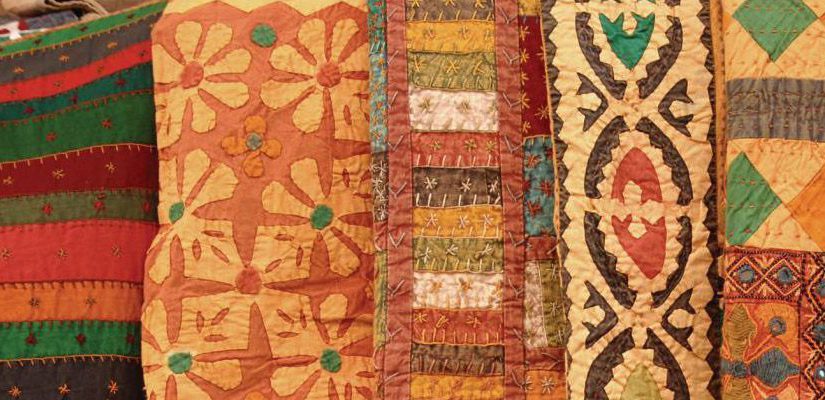
Paintings & Textiles: Weaving Together the Elements of our Culture
“I have learned that each and every piece of cloth embodies the spirit, skill, and personal history of an individual weaver. . . .” – Nilda Callanaupa Alvarez
There are several forms of painting and textile that have made their way to a point nearing-extinction. Mithila and Rogan painting, Parsi and Toda embroidery are endangered along with other art forms such as Kasut of North Karnataka and Patan Patola of Kutch. These traditional art forms have been diminishing in the post-independence period after the promotion of foreign and machine-made goods in India.
Some of the textiles and forms of painting include:
Pattachitra, born in the state of Odisha, is used primarily to depict mythological stories. The Pattachitra paintings are like timelines, painted on fabric, with a blend of tamarind gum and chalk. Sometimes, gold and silver embellishments are used as well.
India is home to the third largest collection of rock art from ancient times. These rock paintings are found along the Aravalli range and in the state of Maharashtra as well.
The Roghan paintings which are made using vegetable dyes, oil and metal blocks and/or a metal stylus. This art form is only known to two families from the same village and is on the verge of extinction, as these families feel that there is nobody left to carry the tradition forward.
There were steps taken by the government and non-governmental sector to help promote the art by increasing their recognition and visibility and giving them a global platform to market their products online.
Manjusha painting, which originated in Bihar is another form of art which is on the verge of extinction. This form of art is represented sequentially, in the form of a story. This art form is nearing extinction since not many know of it and the Government has also been taking up steps to ensure that this form of art lives on.
Apart from these forms of art, India is also home to several fabric dyeing techniques and textile arts. Some of these include Bagh of Madhya Pradesh, a form of block printing done with natural bright colours, and geometric designs. Kalamkari of Andhra Pradesh which is done by stiffening and drying cloth in phases according to a colour scheme – using a bamboo stick and a bundle of fine hair as a brush. Ajrak of the western states of India, originated in the Mohenjo-Daro civilization, is made using the wooden block printing technique as well as vegetable and natural dyes. Dabu of Rajasthan is a mud-resist block printing technique, which involves phases of washing and handprinting. There are several plant and flower motifs used. Sanganeri of Rajasthan uses similar motifs, and is done by using wooden blocks for printing as well. Bandhani, which dates back to the Indus Valley civilization is a very popular dyeing technique which involves tying and dyeing with bright colours. Other forms are Leheriya of Rajasthan which is a form of resist-dyeing, Batik which is a wax-resist dyeing technique and Bagru of Rajasthan, which is over a century old and uses washing, hard dying and drying.
The creativity and craftsmanship that is involved in creating these forms of art is definitely complex and requires a lot of skill. These textiles and techniques boast cultural brilliance and diversity of the country. It also gives us a lot to think about in terms of working hard to preserve these packages of our history and roots.
The artisans of our country who specialise in these very art forms are thoroughly skilled and hardworking individuals who have in their craftsmanship centuries of legacy and brilliance which deserves to be preserved, passed on and given patronage. During these times of a global pandemic and the lockdown situation, the textile artisans are facing a lot more difficulties since there are limited sales with marketplaces shut down. There has also been a shift in the choices of consumers who prefer machine-made fabrics and prints which are economical and serve the purpose they were made for.
It is important for the artisans to be supported now and in the future, since the art that they are experts in will soon die out and this is not just a personal loss to them, but a loss to the entire nation and it would mean that we would be losing a part of who we are.
I like the valuable info you provide in your articles. I’ll bookmark your weblog and check again here regularly. I’m quite sure I’ll learn plenty of new stuff right here! Best of luck for the next!